ABSTRACT
To satisfy demand the power industry, being highly competitive, is required to assure the reliable delivery of energy. This can be achieved by maintaining the integrity of the plant at a reasonable cost, enabled by the optimisation of the asset management process. Decision support tools are utilised for selecting the most appropriate maintenance tasks and times at which they are required to be performed. In the context of a power plant, a tool for supporting maintenance decisions is required; it should integrate various equipment information in order to identify the need for maintenance and it should be based on the quantitative assessment of the current plant condition. The Reliability Maintenance Index for Equipment Profiling (RMI-EP) model is introduced and regarded to be not only applicable to power plant, but to other industries. The model integrates information capable of giving insights into how a piece of equipment is behaving; it enables the estimation of an index representing the need for maintenance, and prioritises the required tasks. Savings in maintenance costs resulting from the application of the RMI-EP model are estimated.
INTRODUCTION
This work has been developed in the field of power generation with the aim of proposing an improved maintenance model that is capable of enhancing a plant’s reliability. A number of different maintenance approaches and tools are currently in general use in the power industry: criticality based, condition based, quantitative analysis methods, reliability centred and computer based systems, among others. All these tools are aimed at providing decision support for selecting the right maintenance tasks and the right times at which they have to be performed.
Here, an improved maintenance model for optimising maintenance activities is introduced. This, the Reliability Maintenance Index for Equipment Profiling (RMI-EP) model, includes the collection of relevant process and maintenance information for a unit or a piece of equipment. An evaluation of the current performance, in order to estimate the need for maintenance, is then made. Finally, the required maintenance tasks are prioritised via a criticality assessment.
The aim of the RMI-EP model, as shown in Figure 1, is to gather all the relevant information for the creation of a profile (an EP) for a piece of equipment. These data are utilised for the estimation of a Reliability-Maintenance Index (RMI), which represents a measure of the need for a particular item to be maintained. The suggested information to be included in this model is shown in Table 1.
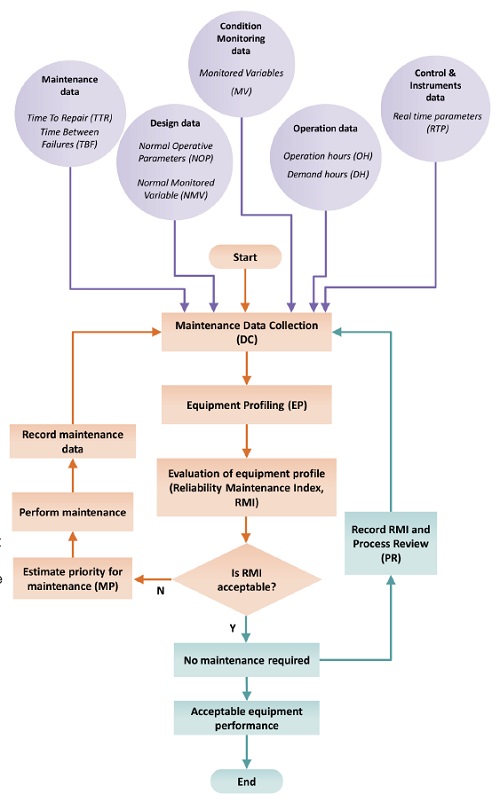
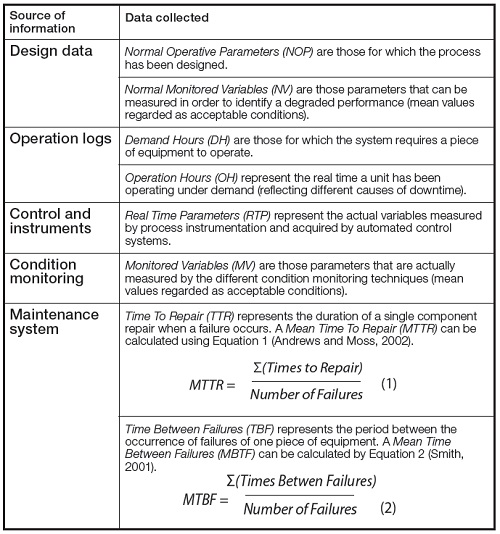
EQUIPMENT PROFILE (EP)
The data listed and defined in Table 1 will be used for the creation of an equipment profile (EP) which should graphically represent the current condition of the piece of equipment. Four main elements of performance, as shown in Figure 2, can be considered by the EP:
- The maintenance profile represents a timetable of maintenance logs, including the current status.
- The operation profile represents the production logs for that piece of equipment, including the current status.
- The operative parameters (the OPs) represent the trends of normal parameters and compare the current measurements against the mean expected values.
- The condition monitoring parameters, in the same way as the OPs, represent any deviation from expected measurements when applicable.
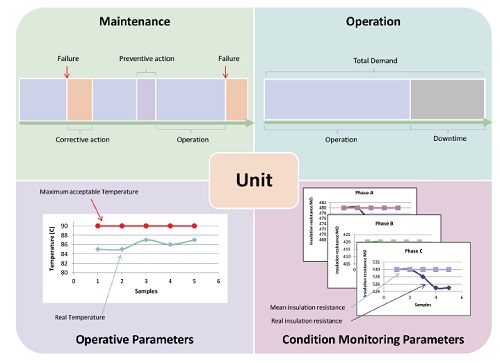
RELIABILITY MAINTENANCE INDEX (RMI)
For the evaluation of the Equipment Profile, a Reliability-Maintenance Index will be estimated. The index is a percentage value of the equipment condition, where 100% represents an excellent performance and indicates that there is no need for maintenance in the short period. The RMI will be estimated from the various data gathered at the earlier stage of this model. These data are first used for the estimation of various sub-indices of reliability and of operational characteristics.
Reliability indices
The Repair Rate (RR) is an indication of the efficiency and ease of repair tasks. It is assumed that repair times follow an exponential distribution (Alebrant Mendes and Duarte Ribeiro, 2014). Thus, the RR index is estimated from Equation 3, which typically represents the Maintainability (Andrews and Moss, 2002).
![]()
where μ is the repair rate, which can be calculated from Equation 4 (Andrews and Moss, 2002).
![]()
The Availability (AV) typically represents the ability of a piece of equipment to operate when its function is demanded. It is estimated from Equation 5.
![]()
The Reliability (RE) typically represents the ability of a piece of equipment to perform its function during a certain period of time. It can be estimated from Equation 6 (Smith, 2001):
![]()
where λ is the failure rate, which can be estimated from Equation 7 (Smith, 2001).
![]()
Operative Indices
The Demand Satisfaction (DS) is an indication of how long a piece of equipment has actually performed its function under demand. It can be calculated from Equation 8 (see Table 1 for definition of the terms), i.e.
![]()
The Operative Parameters Deviation (OPD) represents the difference between measured parameters and their mean expected values. This index is able to reflect degraded conditions and external influences. Typically, for a piece of equipment there is more than one parameter that can be measured, so this index therefore considers a mean value representing all the deviating parameters indicated in Equation 9 and is calculated using Equations 10 and 11 (again, see Table 1 for explanation of the terms).

The Condition Index (CI) is included for units in which any condition monitoring (CM) technique is already implemented. The CI, comprehending a number of different monitored conditions, as indicated in Equation 12, is estimated using Equations 13 and 14 (see Table 1)
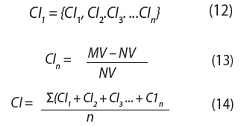
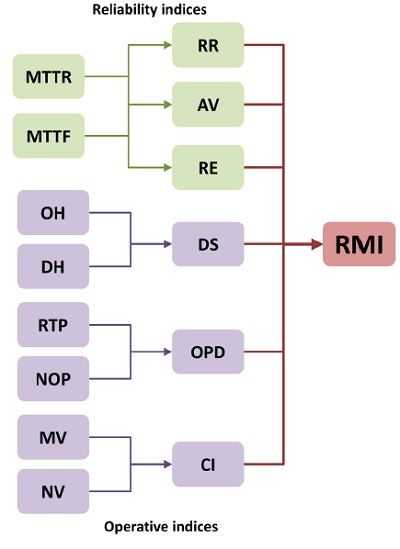
Finally, the Reliability Maintenance Index (RMI) is calculated as the mean value of the six indices, as shown in Figure 3. The selection of an acceptable RMI is to be made according to the particular safety and production requirements in the plant concerned.. As all of the sub-indices utilised for the estimation of the RMI relate to conditions that may degrade over time, it can be assumed that theRMI will also follow a decreasing tendency. Therefore, the RMI rate and distribution are estimated using Equations 15 and 16 i.e.
MAINTENANCE PRIORITY
After the RMI is estimated it is essential to critically analyse the unit under assessment in order to decide whether maintenance is required to be performed immediately or whether it can be scheduled. Thus, as shown in Figure 4, a previously selected acceptable RMI may indicate that no maintenance is needed at the moment. In the case of an estimated deficient RMI, maintenance can be scheduled for units regarded as medium priority; the same applies for an unacceptable RMI in low criticality units. Finally, the immediate need for maintenance is applicable for units with unacceptable RMI and assessed as medium to high criticality items.
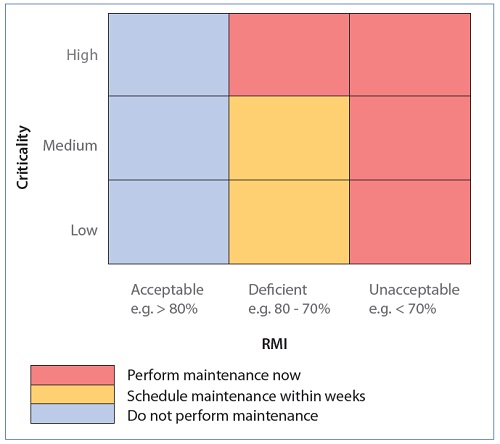
Whether maintenance is triggered by the implementation of the model or not, the information generated must be recorded and included in the Equipment Profile. Additionally, the process must be regularly reviewed for evaluating its effectiveness in supporting maintenance decisions.
EXPECTED BENEFITS FROM IMPLEMENTING THE RMI-EP MODEL
Various benefits are anticipated from the implementation of the proposed model, viz.
(i) integration of relevant information on a piece of equipment into a single system,
(ii) creation of an Equipment Profile representing its current condition,
(iii) execution of maintenance activity only when it is required as indicated by the calculated RMI,
(iv) prioritisation of tasks by assessing equipment criticality,
(v) improved reliability, i.e. longer MTBF, as a result of carrying out maintenance as soon as a degraded condition is detected,
(vi) reduction of costs by eliminating unnecessary maintenance.
Savings in maintenance costs, and the total maintenance costs in a year, resulting from the application of the RMI-EP are estimated as shown in Table 2 and Figure 5.
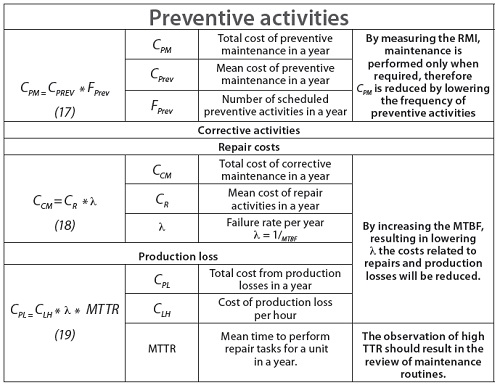
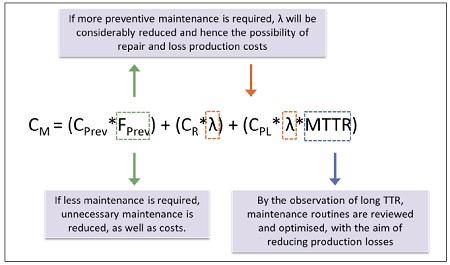
CONCLUSIONS
Information generated every day in any industry may serve as a source of performance analysis. The creation of an Equipment Profile enables the integration of relevant data for a particular unit so that its overall performance can be evaluated. The estimation of a Reliability Maintenance Index (RMI) is proposed as a way to obtain one indicator of equipment behaviour and hence the necessity of performing maintenance activities, which are also critically analysed to be either scheduled or to be carried out immediately. The application of this model will enable the reduction of maintenance costs by eliminating unnecessary maintenance.
ACKNOWLEDGMENT
The first author would like to acknowledge the funding provided by the Mexican National Council of Science and Technology (CONACYT) and the Electrical Research Institute (IIE) for the completion of the MSc programme in Maintenance Engineering and Asset Management at the University of Manchester.
REFERENCES
Garcia Lizarraga, Maria del Carmen. Development of a reliability based maintenance model. MSc Dissertation. The University of Manchester (2014).
Alebrant Mendes A. and Duarte Ribeiro J. L. Establishment of a maintenance plan based on quantitative analysis in the context of RCM in a JIT production scenario. Reliability Engineering and System Safety, 127, 21–29. doi:10.1016/j.ress.2014.03.004 (2014)
Andrews, J. D. and Moss, T. R. Reliability and Risk Analysis (Second Ed.). Professional Engineering Publishing (2002)
Smith, D. J. Reliability, Maintainability and Risk (Sixth Ed.). Butterworth-Heinemann. (2001).
The authors may be contacted at
c.g.lizarraga@gmail.com
Jyoti.sinha@manchester.ac.uk


